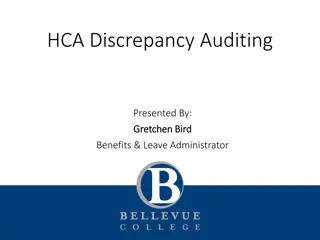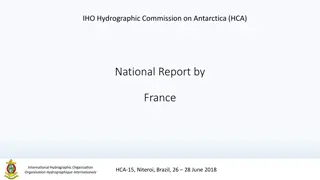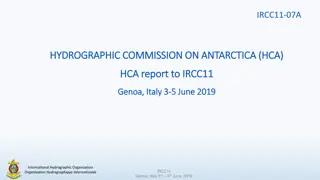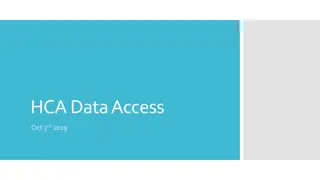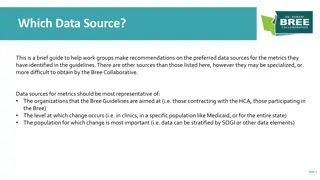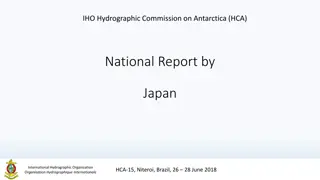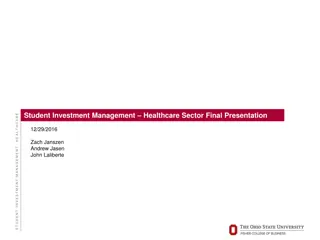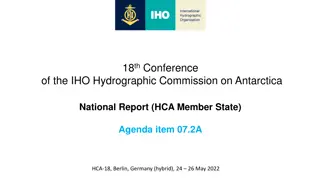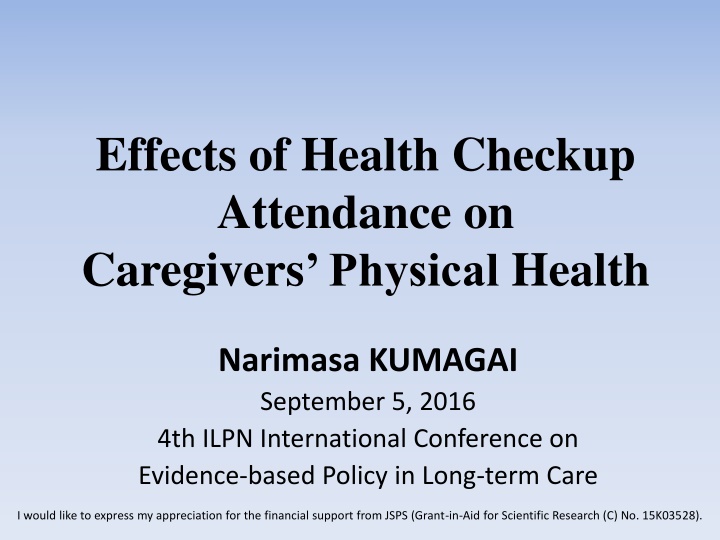
Effects of Health Checkup Attendance on Caregivers' Physical Health Study
Discover how health checkup attendance impacts caregivers' physical health in Japan due to the rising need for informal care. The study investigates the role of caregivers' health checkup participation in preventing poor physical health outcomes and explores the factors influencing attendance.
Download Presentation

Please find below an Image/Link to download the presentation.
The content on the website is provided AS IS for your information and personal use only. It may not be sold, licensed, or shared on other websites without obtaining consent from the author. If you encounter any issues during the download, it is possible that the publisher has removed the file from their server.
You are allowed to download the files provided on this website for personal or commercial use, subject to the condition that they are used lawfully. All files are the property of their respective owners.
The content on the website is provided AS IS for your information and personal use only. It may not be sold, licensed, or shared on other websites without obtaining consent from the author.
E N D
Presentation Transcript
Effects of Health Checkup Attendance on Caregivers Physical Health Narimasa KUMAGAI September 5, 2016 4th ILPN International Conference on Evidence-based Policy in Long-term Care I would like to express my appreciation for the financial support from JSPS (Grant-in-Aid for Scientific Research (C) No. 15K03528).
Background In Japan, as the number of frail older people has risen over time, informal care has come to serve as a substitute for formal long-term care insurance services. -- The government estimates that the nation will need 2.5 million nursing care workers in 2025 when all of the postwar baby boomer generation will have turned 75 or older. However, owing to demographic factors, family members ability to provide informal care is expected to decrease in the coming decade. 2
Background cont. Who will look after Japan's elderly? -- Today, more than a quarter of Japan's population is aged over 65. This is set to increase to 40% by 2055, when the population will have shrunk from the current 127 million to 90 million. The Ministry of Health, Labour and Welfare has warned that Japan will need to add one million nurses and care workers by 2025. BBC News, Japan 16 March 2015 Poor physical health status is more likely in informal caregivers given the roles of living conditions. Caregivers feeling the strain of the role of caregiving responsibility may not promotion activities to maintain their own health. participate in health 3
Objectives Does health checkup attendance (HCA) prevent future poor physical health status of caregivers and if yes, how strong are these dynamics? Using nationally representative longitudinal data, I quantified the degree of persistence in HCA. Drawing on Grossman s model of healthcare demand, this study explored the determinants of HCA among informal caregivers in Japan and analyzed the effect of HCA on caregivers physical health. Keywords health checkup; informal caregiver; Japan; mental health; state dependence 4
Data and Methods Six waves of the Longitudinal Survey of Middle-aged and Elderly Persons (2005 2010) conducted by the Japanese Ministry of Health, Labor and Welfare were used. Having difficulty in daily life activities was used as physical health measures. The Kessler 6 non-specific distress scale was used as mental health measures. The K6 questionnaire of the LSMEP asked respondents how frequently they experienced the following six symptoms - During the past 30 days, about how often did you feel a) nervous, b) hopeless, c) restless or fidgety, d) so depressed that nothing could cheer you up, e) that everything was an effort, and f) worthless? 5
Data and Methods Cont. K6 For each question, a value of zero, one, two, three, or four was assigned to the answer: none of the time , a little of the time , some of the time , most of the time , or all of the time , respectively. Responses to the six items were summed to yield a K6 score between 0 and 24, with higher scores indicating a greater tendency towards mental illness. A K6 cut-off point of 13 was established to operationalize the definition of serious mental illness. Moderate mental distress was defined as 5 K6 < 13.6
Data and Methods Cont. Deterioration of mental health during the past year has negative effects on HCA, but the endogenous causation that mental distress due to informal caregiving may exists. To measure the precise impact of the caregiving on HCA, using the sub-samples defined by the change in mental health, correlated random effects approaches were applied to health checkup functions. I also estimated the physical health functions. Caregivers with regular work were classified as reference category. 7
Health checkup system in Japan An occupational-based or regional-based (community- based) health insurance system. Self-employed individuals, farmers, and retired employees are all enrolled in the National Health Insurance (NHI), and municipalities are the insurers of these individuals. Individuals who are not enrolled in health insurance through their job must enroll in the NHI . NHI provides various types of health checkups to local residents. [General health checkups -> Next slide] The Industrial Safety and Health Law require that all workers undergo annual health checkups in their workplaces. 8
General health checkups General health checkups include the following items: [a] medical history; [b] self-evaluation and objective evaluation of medical symptoms; [c] height, weight, hearing, and vision measurements; [d] chest x-ray radiography; [e] blood pressure measurement; [f] blood lipids test. The programs of basic health checkups are inclusive of a health promotion program containing not only health checkups, but also health counseling and health education (Fukuda et al. 2004). 9
Samples I examined regular employees, irregular employees, and non-working caregivers separately, given their different propensities for providing informal care and their different health habits in HCA. I further delineated non-working caregivers by social status. Specifically, I categorized them as workers during a period of family care leave, individuals who were unemployed, or individuals who were otherwise inactive. Inactive persons included homemakers and retirees. 10
Samples Cont. I created a respondent-level dataset, and limited the sample to individuals who had responded to the item on whether they had received health checkups. This sample ultimately comprised 18,896 respondents, including 8,597 irregular employees (females: males=63:37); 4,445 inactive persons which includes homemakers and retirees (87:13); 4,263 regular employees (36:64); 962 workers with family care leave (87:13); and 629 unemployed people (63:37). Caregivers Non-caregivers Variables Mean SD Mean SD N N Dependent variables Health checkup attendance Dummy for having difficulty in daily life activities 18,720 18,155 0.697 0.128 0.460 0.335 149,102 146,272 0.713 0.090 0.452 0.286 11
Descriptive statistics caregivers versus non-caregivers Poor health status of caregivers compared to non-caregivers Caregivers Non-caregivers Variables Mean SD Mean SD N N Dependent variables Health checkup attendance Dummy for having difficulty in daily life activities Co-residential caregiving Care recipient Father Mother Father in law Mother in law Mental health status Moderate mental health (5 K6 < 13) Serious mental health (13 K6) Demographic variables Age Sex (males=1) Married Never married 18,720 18,155 18,896 0.697 0.128 0.779 0.460 0.335 0.415 149,102 146,272 0.713 0.090 0.452 0.286 18,896 18,896 18,896 18,896 0.170 0.489 0.085 0.265 0.376 0.500 0.278 0.441 18,896 18,896 0.318 0.105 0.466 0.307 150,221 150,221 0.231 0.078 0.422 0.269 18,896 18,896 18,896 18,896 57.462 0.359 0.803 0.185 3.122 0.480 0.397 0.388 150,221 150,221 150,221 150,221 57.147 0.499 0.825 0.159 3.263 0.500 0.380 0.365 12
The receiving rate of health checkups of inactive persons was 60.0%, which was lower than the 66.8% of informal caregivers with part-time work or the 90.3% of informal caregivers with regular work. Descriptive statistics female caregivers versus male caregivers Female caregivers Male caregivers Variables Mean SD Mean SD N N Dependent variables Health checkup attendance Dummy for having difficulty in daily life activities Co-residential caregiving Care recipient Father Mother Father in law Mother in law Mental health status Moderate mental health (5 K6 < 13) Serious mental health (13 K6) Demographic variables Age Married Never married 11,976 11,609 12,105 0.672 0.144 0.762 0.470 0.351 0.426 6,744 6,546 6,791 0.742 0.100 0.809 0.437 0.301 0.393 12,105 12,105 12,105 12,105 0.145 0.436 0.098 0.332 0.352 0.496 0.298 0.471 6,791 6,791 6,791 6,791 0.216 0.585 0.060 0.145 0.411 0.493 0.238 0.352 12,105 12,105 0.336 0.109 0.472 0.312 6,791 6,791 0.286 0.098 0.452 0.297 12,105 12,105 12,105 57.390 0.806 0.180 3.101 0.395 0.384 6,791 6,791 6,791 57.591 0.798 0.193 3.155 0.402 0.395 13
Descriptive statistics cont. female caregivers versus male caregivers Female caregivers Male caregivers Variables Mean SD Mean SD N N Doctor s diagnosis Diabetes Heart disease (angina, myocardial infarction) Cerebral stroke Hypertension Hyperlipidemia Cancer Medical care use and lifestyle Dummy for medication or doctor s consultation Dummy for regular physical activity Dummy for current smoker Dummy for almost every day or every day drinker Dummy for having friends Sources: Longitudinal Survey of Middle-aged and Elderly Persons 2005, 2006, 2007, 2008, 2009 and 2010. 10,435 10,423 10,422 10,475 10,444 10,405 0.065 0.032 0.012 0.233 0.171 0.029 0.246 0.176 0.108 0.423 0.377 0.167 6,046 6,035 6,028 6,056 6,047 6,022 0.143 0.060 0.026 0.291 0.179 0.021 0.350 0.237 0.160 0.454 0.383 0.145 12,105 12,105 12,105 12,105 11,864 0.281 0.481 0.095 0.336 0.874 0.450 0.500 0.293 0.472 0.332 6,791 6,791 6,791 6,791 6,600 0.349 0.421 0.410 0.197 0.796 0.477 0.494 0.492 0.398 0.403 14
Heterogeneity A preliminary analysis revealed that female co- residential caregivers spent more hours on caregiving per week on average than the other caregivers. Hours spent on caregiving per week were as follows: female co-residential, 20.9; male co-residential, 14.36; female non-residential, 15.05; male non-residential, 12.36. The subsamples by employment status showed differences in the intensity of informal caregiving. I take into account employment status of caregivers, which relates to the heterogeneity in the intensity of care provided. 15
Health checkup function This study classified employment status of caregivers into [1] inactive, [2] care leave, [3] unemployment, [4] irregular worker, and [5] regular worker. Under the specifications of the health checkups function, the response probability of a positive outcome depends on unobserved effects and past experience of health checkup behavior. It is important to take unobserved heterogeneity into account because ignoring it can lead to overestimation of the degree of state dependence. 16
Health checkup function cont. D + H? H + L? L + SSt+ WWt+ X? X) HCt = f ( HCHCt-1+ CCt + D? where HC is a measure of HCA, C is a measure of co- residential caregiving, D' is a vector of demographic variables, H' is a vector of the health status of caregivers, L' is a vector of lifestyle variables (e.g., alcohol use, physical activity, smoking), S is social relationships (having friends/acquaintances), W is relative resources of caregivers, and X' is a vector of other socio-economic variables. Relative resources namely, the difference between log- transformed spouse s income and logged respondent's income took a value of zero if the respondent was single. 17
Dynamic random-effects probit model The treatment of initial conditions in a dynamic random-effects probit (DREP) model is crucial, since misspecification results in an inflated parameter of the lagged dependent variable term. Utilizing the procedure described in Wooldridge (2005), Kumagai and Ogura (2014) estimated DREP models and revealed that there was moderate persistence in the dependence between previous health stock and current health stock. Maruotti (2013) showed that a discrete latent process accounts for dependence between the observed process and the initial data mechanism. 18
Health checkups(t-1) Inactive persons 0.305*** (0.0252) 0.433*** (0.112) 0.0167 (0.162) 0.573*** (0.0214) -0.348*** (0.0455) 0.404 (0.359) -0.660*** (0.221) 0.125*** (0.0246) Distinct impacts on HCA Care leave Unemployed Irregular employees Co-residential caregiving led to the change in HCA more than non- residential caregiving. Considering the change in mental health is very important when we analyze the impact of co-residential caregiving on HCA. Caregiving Non-residential caregiving -0.423*** -0.0576 -0.314*** (0.0864) Co-residential caregiving Inactive persons -0.686*** (0.0668) -0.592*** (0.134) -0.597*** (0.187) -0.558*** (0.0616) -0.615*** (0.179) -0.664* (0.388) -0.484* (0.273) -0.703*** (0.0867) Care leave Unemployed Irregular employees Change in mental health status -0.0356** (0.0152) 0.0152 (0.0179) (Moderate or serious mental distress) 19
Results This study uncovered four major findings. 1 There are distinct impacts of informal caregiving on HCA. Almost 40% of the probability of HCA was reduced by co- residential caregiving in females and males. 2 There was not moderate persistence in HCA of most non-working caregivers such as inactive persons, although having hypertension or hyperlipidemia, medication or doctor s consultation, and regular physical activity (RPA) had positive effects on caregivers HCA. Considering the population distribution of unobserved heterogeneity, almost 40% of the probability of HCA was reduced by co-residential caregiving in females and males( ?=-0.413 when ? =-0.6, ?=1.0535) because population-averaged parameters were obtained as ??= ? (1 + ??2) . 20
Results Cont. The averaged parameter of lagged health checkups of female inactive caregivers was 0.210 (0.305/1.4525). 3 Considering the change in mental health is very important when we analyze the impact of co-residential caregiving on HCA. Almost 75% of the probability of HCA was reduced by co-residential caregiving in female inactive persons whose mental health was deteriorated during the past year. Females Males (Moderate or serious mental health) (Moderate or serious mental health) Unchanged Deteriorated Improved Unchanged Deteriorated Improved Co-residential caregiving Inactive persons -0.686*** (0.0668) -0.718*** (0.0759) -1.022*** (0.178) -0.736*** (0.199) -0.615*** (0.179) -0.715*** (0.205) -1.946*** (0.678) -0.672 (0.549) 21 -1.022/1.357
Effects of health checkup attendance on caregivers physical health Sisk (2000) found that those perceiving lower subjective burden practice more health-promoting behaviors than those with higher subjective burden scores. To estimate physical health functions, therefore, I used the sub-samples defined by the change in mental health. Female inactive persons and irregular employees HCA RPA were negative significant at the 5 percent level when those caregivers mental health status was unchanged during the past year (N=28081). 22
Results Cont. Random-effects probit model for Difficulty in daily life activities(t)=0 4 Health promotion behaviors such as HCA and RPA reduce the risk of future poor physical health of female inactive persons and irregular employees. However, the positive effect of health promotion behaviors on future physical health did not exceed the negative effect of caregiving. Dependent variables Difficulty in daily life activities (t+1) Females (Moderate or serious mental health) Unchanged Deteriorated Improved Health checkups(t) regular physical activity(t) Inactive persons -0.130** (0.0620) 0.664 (0.416) 0.192 (0.621) -0.118** (0.0528) 0.0264 (0.0984) -0.175 (0.467) - -0.299* (0.157) (omitted) Care leave Unemployed 6.792 (3,071) -0.152 (0.124) Irregular employees 0.0735 (0.0828) Caregiving Non-residential caregiving -0.0657 (0.109) 0.260*** (0.0929) -0.352 (0.302) -0.0247 (0.381) 0.205*** (0.0786) 0.192 (0.164) -0.0821 (0.147) 0.347 (0.267) 0.400 (0.402) -0.0548 (0.121) -0.454 (0.283) 0.265 (0.221) 1.019** (0.459) -6.245 (3,071) 0.0784 (0.190) Inactive persons Care leave Unemployed Irregular employees 23 N 28081 4190 4266
Results Cont. In addition to health promotion behaviors, having friends is important. The effect of having friends on future poor physical health was negative significant at the 1 percent level in females and males. The effect of RPA on future physical health may be cancelled out by caregivers mental health distress. Females Males (Moderate or serious mental health) (Moderate or serious mental health) Unchanged Deteriorated Improved Unchanged Deteriorated Improved Having friends -0.166*** (0.0574) -0.173*** (0.0445) -0.180** (0.0846) -0.216 (0.134) -0.169 (0.108) -0.239* (0.134) 24
Results Cont. Unchanged Male caregivers having stroke did not attend health checkup and tended to have future poor physical health. Why not HCA and RPA reduce the risk of future poor physical health of males? Health checkups(t) regular physical activity(t) Inactive persons 0.158 (0.0984) -0.240 (0.805) -0.270 (0.815) -0.117* (0.0609) Care leave Unemployed Irregular employees ----- Using bivariate probit models, I confirmed that HCA reduced the probability of future poor physical health in males excluding inactive persons. Males with higher income engaged in moderate or vigorous physical activity, and tended to have lower probability of future poor physical health. -> The other specification might be examined. 25
Policy Implications Compared to non-caregivers, female caregivers did not tend to select HCA. Because of the potential negative effects of informal caregiving on caregivers health, the support of informal caregivers combined with regular health checks is an important public health issue. The estimation results suggested that female inactive persons and irregular employees may benefit from HCA. When providing preventive intervention to stay caregivers healthy, the primary doctor should pay attention to mental health status and lifestyle of informal caregivers. 26

